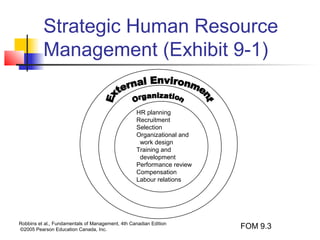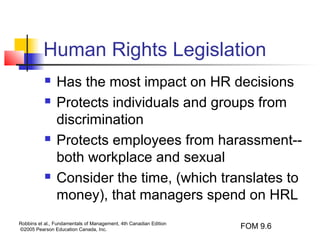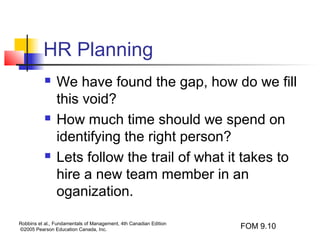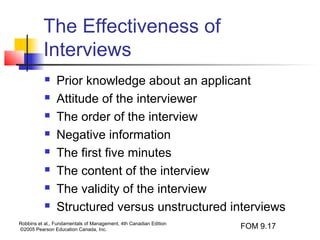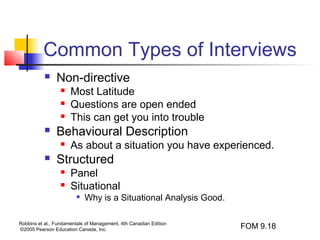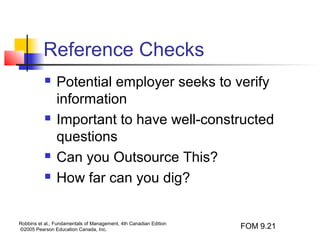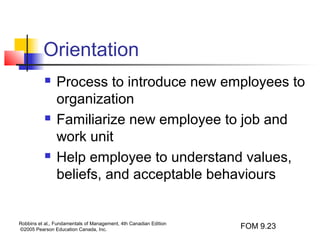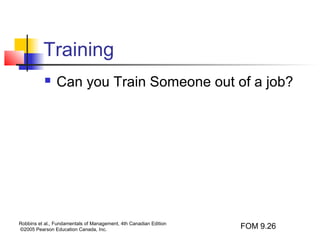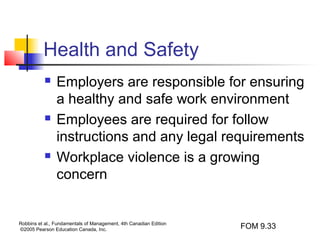Hr slide 7
- 1. FOM 9.1Robbins et al., Fundamentals of Management, 4th Canadian Edition ©2005 Pearson Education Canada, Inc. Chapter 9 Human Resource Management
- 2. FOM 9.2Robbins et al., Fundamentals of Management, 4th Canadian Edition ©2005 Pearson Education Canada, Inc. Human Resource Management The integration of all processes, programs, and systems in an organization that ensure staff are acquired and used in an effective way
- 3. FOM 9.3Robbins et al., Fundamentals of Management, 4th Canadian Edition ©2005 Pearson Education Canada, Inc. Strategic Human Resource Management (Exhibit 9-1) HR planning Recruitment Selection Organizational and work design Training and development Performance review Compensation Labour relations
- 4. FOM 9.4Robbins et al., Fundamentals of Management, 4th Canadian Edition ©2005 Pearson Education Canada, Inc. Strategic Importance of HRM Can establish an organization’s sustainable competitive advantage Shortfall of 500 million workers Requires fundamental change in how managers think about employees Partners and Investments Need to consider outsourcing certain HR transactions But then what does the HR dept. do?
- 5. FOM 9.5Robbins et al., Fundamentals of Management, 4th Canadian Edition ©2005 Pearson Education Canada, Inc. Legal Environment of HRM Federal and provincial governments influenced HRM through laws and regulations Huge increase in this since 1960’s Employers must ensure that managers understand their obligations and comply Four primary areas of employment legislation Lets look at the Main One
- 6. FOM 9.6Robbins et al., Fundamentals of Management, 4th Canadian Edition ©2005 Pearson Education Canada, Inc. Human Rights Legislation Has the most impact on HR decisions Protects individuals and groups from discrimination Protects employees from harassment-- both workplace and sexual Consider the time, (which translates to money), that managers spend on HRL
- 7. FOM 9.7Robbins et al., Fundamentals of Management, 4th Canadian Edition ©2005 Pearson Education Canada, Inc. Other Employment Legislation Employment standards Basic or minimum employment conditions in an organization Minimum wage, hours of work, OT pay Health and safety Healthy and Safe work Environment On the Job Injuries Labour relations Relationship between union and employer Not all organizations are covered by Labour Relations
- 8. FOM 9.8Robbins et al., Fundamentals of Management, 4th Canadian Edition ©2005 Pearson Education Canada, Inc. Global Laws and HRM Laws and regulations are not the same throughout the world Working Conditions, Pay, H&S Important for manage to know the legislation in the country in which they are working
- 9. FOM 9.9Robbins et al., Fundamentals of Management, 4th Canadian Edition ©2005 Pearson Education Canada, Inc. Human Resource Planning Assessing Future Human Resource Needs Assessing Current Human Resources Developing a Program to Meet Needs
- 10. FOM 9.10Robbins et al., Fundamentals of Management, 4th Canadian Edition ©2005 Pearson Education Canada, Inc. HR Planning We have found the gap, how do we fill this void? How much time should we spend on identifying the right person? Lets follow the trail of what it takes to hire a new team member in an oganization.
- 11. FOM 9.11Robbins et al., Fundamentals of Management, 4th Canadian Edition ©2005 Pearson Education Canada, Inc. Recruitment Process of locating, identifying, and attracting capable candidates Can be for current or future needs Critical activity for some corporations. What sources do we use for recruitment
- 12. FOM 9.12Robbins et al., Fundamentals of Management, 4th Canadian Edition ©2005 Pearson Education Canada, Inc. Recruitment Sources Internal Searches Employee Referrals Employee Leasing Temp Services Employment Agencies Advertisements School Placement
- 13. FOM 9.13Robbins et al., Fundamentals of Management, 4th Canadian Edition ©2005 Pearson Education Canada, Inc. Selection Prediction exercise Thus, Not Perfect Decision-making exercise Purpose is to hire the person(s) best able to meet the needs of the organization Tied Back to Strategy
- 14. FOM 9.14Robbins et al., Fundamentals of Management, 4th Canadian Edition ©2005 Pearson Education Canada, Inc. Selection Are there ways that managers can ensure that the decision achieves the desired outcome? (time and time again) Yes, use HR Tools which are Reliable & Valid
- 15. FOM 9.15Robbins et al., Fundamentals of Management, 4th Canadian Edition ©2005 Pearson Education Canada, Inc. Reliability Degree to which selection tool measures the same thing consistently Can be a test or an interview Same questions need to be asked.
- 16. FOM 9.16Robbins et al., Fundamentals of Management, 4th Canadian Edition ©2005 Pearson Education Canada, Inc. Validity Relationship between selection tool and appropriate criterion What a selection technique measures and how well it measures Must be proven and relevant to job Eg: keyboarding skills for data entry clerk.
- 17. FOM 9.17Robbins et al., Fundamentals of Management, 4th Canadian Edition ©2005 Pearson Education Canada, Inc. The Effectiveness of Interviews Prior knowledge about an applicant Attitude of the interviewer The order of the interview Negative information The first five minutes The content of the interview The validity of the interview Structured versus unstructured interviews
- 18. FOM 9.18Robbins et al., Fundamentals of Management, 4th Canadian Edition ©2005 Pearson Education Canada, Inc. Common Types of Interviews Non-directive Most Latitude Questions are open ended This can get you into trouble Behavioural Description As about a situation you have experienced. Structured Panel Situational Why is a Situational Analysis Good.
- 19. FOM 9.19Robbins et al., Fundamentals of Management, 4th Canadian Edition ©2005 Pearson Education Canada, Inc. Interview Questions Lets come up with some interview questions!
- 20. FOM 9.20Robbins et al., Fundamentals of Management, 4th Canadian Edition ©2005 Pearson Education Canada, Inc. Written Tests Intelligence General aptitude Ability Interest
- 21. FOM 9.21Robbins et al., Fundamentals of Management, 4th Canadian Edition ©2005 Pearson Education Canada, Inc. Reference Checks Potential employer seeks to verify information Important to have well-constructed questions Can you Outsource This? How far can you dig?
- 22. FOM 9.22Robbins et al., Fundamentals of Management, 4th Canadian Edition ©2005 Pearson Education Canada, Inc. Your Hired Now What? Most Important Stage
- 23. FOM 9.23Robbins et al., Fundamentals of Management, 4th Canadian Edition ©2005 Pearson Education Canada, Inc. Familiarization to Organization and its Values Improved Success On the Job Minimizes Turnover Orientation Process to introduce new employees to organization Familiarize new employee to job and work unit Help employee to understand values, beliefs, and acceptable behaviours
- 24. FOM 9.24Robbins et al., Fundamentals of Management, 4th Canadian Edition ©2005 Pearson Education Canada, Inc. Training and Development Learning experience that seeks relatively permanent change Involves changing skills, knowledge, attitudes or behaviours Training tends to be done for current job Develop usually means acquiring skills for future work
- 25. FOM 9.25Robbins et al., Fundamentals of Management, 4th Canadian Edition ©2005 Pearson Education Canada, Inc. Employee Training What deficiencies, if any, does job holder have in terms of skills, knowledge, abilities, and behaviours? What behaviours are necessary? Is there a need for training? What are the strategic goals of the organization? What tasks must be completed to achieve goals?
- 26. FOM 9.26Robbins et al., Fundamentals of Management, 4th Canadian Edition ©2005 Pearson Education Canada, Inc. Training Can you Train Someone out of a job?
- 27. FOM 9.27Robbins et al., Fundamentals of Management, 4th Canadian Edition ©2005 Pearson Education Canada, Inc. Performance Management Integration of management practices that includes a formal review of employee performance How often should this take place? Includes establishing performance standards and reviewing the performance Means to ensure organizational goals are being met
- 28. FOM 9.28Robbins et al., Fundamentals of Management, 4th Canadian Edition ©2005 Pearson Education Canada, Inc. Multiperson Graphic Rating Scales Critical Incidents Written Essay BARS Performance Review Methods 360-Degree Review MBO
- 29. FOM 9.29Robbins et al., Fundamentals of Management, 4th Canadian Edition ©2005 Pearson Education Canada, Inc. If Performance Falls Short Train Discipline Coach Out the Door
- 30. FOM 9.30Robbins et al., Fundamentals of Management, 4th Canadian Edition ©2005 Pearson Education Canada, Inc. Compensation Management Process of determining cost-effective pay structure Designed to attract and retain Provide an incentive to work hard Structured to ensure that pay levels are perceived as fair
- 31. Factors That Influence Compensation Unionization Level of Compensation and Benefits Employee’s tenure and performance Kind of job performedSize of company Management philosophy Kind of businessGeographical location Labour- or capital-intensive Company profitability FOM 9.29 Robbins et al., Fundamentals of Management, 4th Canadian Edition ©2005 Pearson Education Canada, Inc. Source: Management, Seventh Canadian Edition, by Stephen P. Robbins, Mary Coulter, and Robin Stuart-Kotze, page 274. Copyright © 2003. Reprinted by permission of Pearson Education Canada Inc.
- 32. FOM 9.32Robbins et al., Fundamentals of Management, 4th Canadian Edition ©2005 Pearson Education Canada, Inc. Employee Benefits Indirect financial rewards Designed to enrich employees’ lives Vary widely in scope Costs range from 30% to 40% of payroll costs
- 33. FOM 9.33Robbins et al., Fundamentals of Management, 4th Canadian Edition ©2005 Pearson Education Canada, Inc. Health and Safety Employers are responsible for ensuring a healthy and safe work environment Employees are required for follow instructions and any legal requirements Workplace violence is a growing concern
- 34. FOM 9.34Robbins et al., Fundamentals of Management, 4th Canadian Edition ©2005 Pearson Education Canada, Inc. Labour Relations Relationship between union and employer Union functions as the voice of employees Collective bargaining is a process to negotiate terms and conditions of employment Bargaining produces a written document called a collective agreement
Editor's Notes
- 1
- The quality and effectiveness of the organization is determined by the quality of the people that are employed. Success for most organizations depends on finding the employees with the skills to successfully perform the tasks required to attain the company’s strategic goals. Management decisions and processes for dealing with employees are critical to ensure that the organization gets and keeps the right staff. In order to get the most out of staff, human resource management integrates all processes, programs, and systems in an organization designed to ensure that employees are acquired and used in an effective way.
- These are the key HR processes in an organization. You will note that these processes do not function in isolation: HR management functions within the culture of the organization . And of course, the organization is impacted by its environment. By paying careful attention to these facts, an organization can recruit competent, high-performing employees who are capable of sustaining their performance over the long term. You will also see that many factors introduced in Chapter 1 (for example, globalization, technology, and demographics) directly affect all management practices, but their effect is probably greatest in the management of human resources. This is because that whatever happens to an organization ultimately influences what happens to its employees.
- HRM not only can be a strategic tool, it can also help establish an organization’s sustainable competitive advantage. Retaining good workers has become even more important as it is projected that there will be a shortage of nearly a million workers in Canada in the future. Achieving competitive success through people requires a fundamental change in how managers think about their employees and how they view the work relationship. It involves seeing employees as “partners” not just as costs to bed minimized or avoided. And as shown in the example in E-Business and Management, banks are outsourcing HR transactions so that its HR energies are focused on working with business leaders to achieve business results.
- Since the mid-1960s, federal and provincial legislation has greatly influenced human resource management. As a result, employers must ensure that managers and supervisors, as well as employees, understand the company’s and their obligations under the laws. For example, decisions as to who will be hired must be done without regarding to race, gender, religion, etc. The four primary areas of employment laws will be discussed in more detail.
- The most significant impact on human resource management comes from human rights legislation. This is the legislation that protects individuals and groups from discrimination and harassment in many areas of employment. Discrimination is prohibited on a number of groups (refer to Exhibit 9-2) and requires that decisions are made impartially. Harassment is also covered by human rights legislation. Generally speaking, harassment includes any and all forms of unwelcome behaviour. Most of the focus on the last several years has been on sexual harassment --any unwanted activity of a sexual nature that affects an individual’s employment. Sexual harassment is a serious issue in both public and private sector organizations and it is a global issue. Managers must be vigilant to prevent this or else there are costly consequences to the organization.
- The other three primary areas of employment legislation is: Employment standards--refers to the basic or minimum employment conditions in any organization. Includes things such as minimum wage, hours of work, what constitutes overtime pay, etc. Health and safety--applies to all organizations and recent changes have placed more responsibility on employees for the creation and maintenance of a healthy and safe work environment. This legislation also provides a monetary payment if a person is injured on the job. Labour relations--governs the relationship between a trade union and an employer. As a result, not all organizations are covered by this legislation--only those that have unionized employees.
- It is important to note that employment laws are not universal. Even the employment legislation in the US is different than in Canada where the laws in the U.S. are more centralized whereas the employment laws in Canada are decentralized to the provincial level. Likewise, employees in Mexico are more likely to be unionized than in Canada and Australia’s discrimination laws weren’t enacted until the 1980s where only women are protected.
- 6 Since it is important to have the right people in the right jobs at the right time, human resource planning is the process to achieve that. What the organization will do is make an assessment of the current capabilities of its employees, determine what it will need in the future, and design a program to meet those needs. Depending on the organization’s objectives and strategies, demand for human resources is contingent upon demand for the organization’s products or services and on the levels of productivity. After estimating total revenue, management can estimate the number and kinds of human resources needed to obtain those revenues. After it has assessed current capabilities and future needs, management can estimate future human resources shortages and over-staffing. Then, it can develop a program to match these estimates with forecasts of future labour supply.
- 7 Once managers know their staffing needs, they can begin to look for capable people to fill those needs. The process to do this is called recruitment. It is a process that locates, identifies, and attracts capable candidates for the work. For many organizations, this has become a critical activity. As the business demands change, so do the skills required. And there are some skill sets that are in high demand which means organizations have to have a good plan to locate the people with the unique skills.
- 8 But where do companies go to recruit employees? Many companies are finding new employees through the Internet. Organizations that are looking for people with a high-level of technological skills may focus their recruitment efforts by using the Internet. The web sites of organizations frequently have a link for enabling the browser to submit a resume. The source that is used should reflect the labour market, the type or level of position, and the size of the organization. Are certain recruiting sources better than others? Recent studies have demonstrated that employee referrals generally produce the best candidates. This is because current employees screen applicants before referring them. Second, current employees believe that their reputations with the firm will be reflected in the candidates that they recommend; so, they refer only those who they believe will not make them look bad. Employee referrals, however, may not generate the diversity and mix of employees that is desirable.
- 10 After the completion of the recruitment process, the manager needs to decide who to hire. Selection is essentially both a prediction exercise and a decision-making exercise. In the prediction exercise, the manager is predicting which applicant will be successful on the job is hired. The manager is also undertaking a decision-making exercise--choosing among choices. It is important to always keep in mind that the manager is selecting the person who can best meet the needs of the organization.
- 12 Are there ways that managers can ensure that the decision achieves the desired outcome? For any selection tool to be effective, it must be both reliable and valid. Reliability refers to the degree that the selection tool measure the same thing from one time to another. An example would be that a test needs to measure the same attribute from one time to another. The concept is similar to being able to rely on the temperature gauge on an oven. If you set the oven for 350Þ, you want to know that the temperature in the oven will be 350Þ from one time to another.
- 13 As mentioned earlier, for the selection tool to be effective, it must also be valid. Validity refers to the relationship of the selection tool to some relevant factor in the job. For example, if the person needs to be able to input data quickly into a data base, then it would be appropriate to assess the person for keyboarding skills. However, if the person infrequently did any data entry, then assessing how fast the person keyboards may not be a valid measure.
- 15 Managers can use a number of selection techniques to make good hiring decisions. The most widely-used selection tool is the interview. However, interviews are often neither reliable nor valid. Therefore, the person with the best interview skills often gets the job, even though he or she may not be the most qualified. Interviews are valuable for assessing an applicant’s intelligence, level of motivation, and interpersonal skills. Unstructured interviews are conducive to interviewer biases: favouring applicants who share their values, giving undue weight to negative information, and allowing the order in which applicants are interviewed to influence evaluations. Structured interviews provide standardized sets of questions, uniform methods of recording information, and standardized ratings of the qualifications of applicants. If interviews are not well structured and standardized, they can be biased. There have been a number of research findings on interviews which can be summarized as follows: Prior knowledge about the applicant will bias the interviewer. Interviewers hold stereotypes about what represents “good” applicants. Interviewers favour applicants who share their own attitudes. The order in which applicants are interviewed affects assessments of candidates. Negative information is given unduly high weight. Interviewers determine an applicant’s suitability in the first five minutes of the interview. Interviewers forget much of an interview’s content within minutes after it has been ended. Interviews are most valid in determining an applicant’s intelligence, motivation, and interpersonal skills. Structured, well organized interviews are more effective than those that are loosely organized.
- There are two general types of interviews: non-directive and structured. Non-directive interviews provide the maximum latitude to the person being interviewed--questions are broad and open-ended. Within structured interviews, there are panel, situational and behavioural description. The panel interview has a number of people involved each observing and making notes. The situational interview focuses on asking applicants about hypothetical situations. For example, “It is the end of your shift and someone calls in sick. What would you do?” The behavioural description interview, on the other hand, focuses on asking the applicant about a situation that they have experienced. For example, “Describe a time that you had a customer screaming at you. What did you do and what was the outcome?”
- Written tests were widely used until the early 1960s when they fell into disfavour. They were frequently characterized as discriminatory and not job related. However, since well-constructed tests can help predict success on the job, tests have made a comeback. It is, though, important that organizations use tests that are reliable and valid and have been designed to measure the skill or ability. Good tests can help reduce the likelihood of making a poor hiring decision.
- Reference checks occur when a potential employer contacts previous employers to verify information that the applicant has provided. It is important to ask good questions in order to get the information necessary to make a good hiring decision.
- 17 Besides having the requisite knowledge, skills, and abilities to perform on the job, new hires must be socialized to the organization’s culture (orientation) and trained to do the job (training). Orientation is a process whose major objectives are to reduce the anxiety level that all new employees feel; to familiarize them with the job, the work unit, and the organization; and to embed organizational values, beliefs, and accepted behaviours. Successful orientation maximizes new hire on-the-job success and minimizes turnover.
- Training and development is important to ensure that people continue to learn skills, etc. to help the company be successful. Employee training is a learning experience that seeks a relatively permanent change in employees such that their ability to perform at their current job improves. This may mean changing what employees know, how they work, or their attitudes toward their jobs, co-workers, managers, and the organization. Management is responsible for deciding when employees are in need of training and development and what form it should take.
- 18 However, before any training takes place, and organization should determine is training is the appropriate intervention. Managers can be alerted to training needs by numerous signals: for instance, productivity related signals like decreases in output and quality or increases in accidents; and, future elements like jobs that have been redesigned or technological breakthroughs. Most training takes place on the job. Such training is convenient and cost effective. But, on-the-job training can disrupt the workplace, and some skills are too complex to learn on the job. In such cases, training should take place outside of the work setting.
- 20 It is important for managers to help their employees achieve the results expected. This is done through managing the performance of the employees the manager is responsible for. In managing performance, the manager identifies and communicates the expected performance standards and then evaluates or measures the performance against the standard. There are a variety of ways to assess a person’s performance which we will review next.
- 21 There are several ways in which managers can evaluate or measure the performance of their employees. Written essays that describe an employee’s performance and suggestions for improvement require no complex forms or extensive training. But a good or bad appraisal may depend as much on the writing skill of a manager as on the actual performance of an employee. With the critical incidents method, the appraiser writes down what an employee did that was especially productive or counterproductive. The key is to cite specific and key behaviours. With graphic rating scales , performance factors are listed such as quantity and quality of work, depth of knowledge, or initiative. The appraiser then rates each factor on an incremental scale. This method cannot provide the depth of information of essays or critical incidents, but it is less time consuming to develop and administer, and yields results that can be quantified. Behaviorally anchored rating scales BARS combine the critical incidents and graphics rating scale approaches. The appraiser rates employees on items along a continuum. The points along the scale are examples of actual on-the-job behaviour rather than general descriptions or traits. Multiperson comparisons are relative measuring devices. Group order ranking requires the rater to place employees into a particular classification, such as the top one-fifth. Individual ranking orders employees from best to worst. Paired comparisons rank each employee with all other employees and rates each as either the weaker or superior member of the pair. MBO, which was discussed in Chapter 5, assesses employees on how well they accomplish a specific set of objectives that have been determined to be critical in the successful completion of their jobs. Because MBO emphasizes ends rather than means, this method allows managers to choose the best path for achieving their goals. A 360-degreereview seeks feedback for the person being rated from a variety of sources: such as peers, supervisors, and customers. Research shows that 360-degree appraisals offer more accurate feedback, empower employees, reduce subjective factors in evaluation, and develop leadership in an organization.
- If an employee not meeting the performance goals, the manager needs to determine what is going on. It could be because the employee is mismatched for the job or because the training was insufficient. If this is the case, the manager can either reassign the person to more suitable work or to train the person. However, if the problem results from the person not desiring to do the job, then it is a discipline problem. If the employee has a discipline problem , the manager can rely on employee coaching and disciplinary action. A process intended to help an employee overcome performance-related problems, employee coaching attempts to discover and remedy the reasons for poor performance. Employee coaching can benefit both the company and the employee. But, if the worker either cannot or will not accept help, then management must use discipline to enforce the expected performance or acceptable behaviours and actions of the organization.
- 23 How does management decide who will get paid $12.65 an hour and who will receive $325,000 per year? The answer lies in compensation administration : the process of determining a cost-effective pay structure that attracts and retains competent employees, provides incentives for hard work, and ensures that pay levels will be perceived as fair. The primary determination of pay is the kind of job an employee performs: that is, the higher the skills, knowledge, and abilities—and the greater the authority and responsibility—the higher the pay. Other factors which influence employee compensation are the nature of the business, the environment surrounding the job, geographic location, and employee performance levels and seniority. Regardless of these factors, there is one other most critical factor: management’s compensation philosophy. Some organizations don’t pay employees any more than they have to while other organizations want to pay people above are salary levels.
- There are a number of factors that can influenced compensation levels. This slide (Exhibit 9-7) displays the various factors. For example, private-sector jobs typically provide higher rates of pay than comparable positions in public and not-for-profit jobs. Likewise, employees who have been with an organization for a long time may have had a salary increase each year. Because skill levels tend to affect work efficiency and effectiveness, many organizations have implemented skill-based or competency-based pay systems. These types of systems reward employees for the job skills and competencies they can demonstrate. These systems also tend to mesh nicely with the changing nature of work and today’s work environment. But the most critical factor is management’s compensation philosophy.
- 24 In addition to the salary or wage an employee receives, the employee will usually have some employee benefits. As indirect financial rewards intended to enrich employee’s lives, today’s employee benefits programs seek to provide something that each employee can value. Some of the benefits are required by legislation such as Canada Pension Plan while others are voluntarily provided such as life insurance coverage. The scope of these benefits varies considerably.
- Both employers and employees have an obligation to follow health and safety legislation. There is a growing concern for safety on the job because no organization is immune from workplace violence. Companies want to prevent violence from occurring. But because the circumstances of each incident are different, a specific plan of action for companies is difficult to detail. However, several suggestions can be made. First, the organization must develop a plan to deal with the issue. Furthermore, organizations must train managers to identify troubled employees before the problem results in violence. Organizations should also implement stronger security measures.
- Labour relations refers to the relationship that exists between an organization and a union. It has evolved over time and is governed by legislation. The role of the union is to be the voice of employees, particularly during collective bargaining. Collective bargaining produces a collective agreement which is a legal document outlining the terms and conditions of employment. If an employee or union feels that the company is violating the collective agreement, a grievance may be initiated.


